| University of St Andrews |
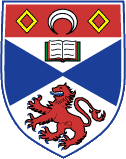 |
拉丁语: Universitas Sancti Andreae apud Scotos
(University of St Andrew amongst the Scots) |
| 校训 |
ΑΙΕΝ ΑΡΙΣΤΕΥΕΙΝ (AIEN ARISTEUEIN) (Greek: Ever To Be The Best) |
| 建立于 |
1410–1413 |
| 类型 |
Public university |
| 捐赠 |
£34.8 million |
| Chancellor |
Sir Menzies Campbell |
| Rector |
Kevin Dunion |
| Principal |
Dr Louise Richardson |
| 工作人员 |
1,804 (all)
817 (academic) |
| 学生 |
8,645 |
| 本科生 |
6,760 |
| 研究生 |
1,885 |
| 位置 |
St Andrews, Fife, Scotland, UK
56°20′28.37″N 2°47′34.84″W / 56.3412139°N 2.7930111°W / 56.3412139; -2.7930111Coordinates: 56°20′28.37″N 2°47′34.84″W / 56.3412139°N 2.7930111°W / 56.3412139; -2.7930111 |
| Colours |
University of St Andrews
St Mary's College
Bute Medical School
St Leonard's College
|
| 归属 |
1994 Group |
| 网址 |
st-andrews.ac.uk |
The University of St Andrews, founded between 1410 and 1413, is the oldest university in Scotland and the third oldest in the English-speaking world. The University is situated in the town of St Andrews, in Fife, on the east coast of Scotland.
The University of St Andrews is a member of the Sutton 13 and the 1994 Group, a small network composed by several universities dedicated to perform intensive research in the United Kingdom. In 2010 The Guardian ranked the university third best within the UK, after Oxford and Cambridge, and it is regarded as one of the most prestigious universities in the United Kingdom. It was ranked first in student satisfaction.
历史
Main article: History of the University of St Andrews
The University was founded in 1410 when a charter of incorporation was bestowed upon the Augustinian priory of St Andrews Cathedral. A Papal Bull was issued in 1413 by the Avignon Pope Benedict XIII. A royal charter was granted in 1532. The University grew in size quite rapidly; A pedagogy, St John's College was founded 1418-1430 by Robert of Montrose and Lawrence of Lindores, St Salvator's College was established in 1450, St Leonard's College in 1511, and St Mary's College in 1537. St Mary's College was a re-foundation of St Johns College and earlier pedagogy. Some of the early college buildings that are in use today date from this period such as St Salvator's Chapel and St Leonards College chapel and St Mary's College quadrangle. At this time, much of the teaching was of a religious nature and was conducted by clerics associated with the cathedral.
From the 17th to 19th centuries, the university underwent many changes. Toward the end of the seventeenth century, the university considered and eventually rejected a move to Perth. In 1747, St Salvator's and St Leonard's merged to form the United College of St Salvator and St Leonard.
During the 19th century, student numbers were very low, in the 1870s, the student population was fewer than 150, and perhaps partly in response to this, the university founded University College in Dundee in 1897, which became a centre of medical, scientific and legal excellence. This affiliation ended in 1967 when the college, renamed Queen's College, became a separate and independent institution as the University of Dundee. The loss of teaching facilities for clinical medicine caused the university's Bute Medical School to form a new attachment with the University of Manchester, which was then expanding its clinical medicine intake.
Terms
The university operates an unusual system of two terms. The terms are called Martinmas and Candlemas. The Martinmas term runs from late September until Mid January. There are 12 teaching weeks in this term which all occur before Christmas and then examinations are held after Christmas. After Examinations there is an inter-semester break, known as 'ski-week' and then the new semester begins in early February.
Reputation
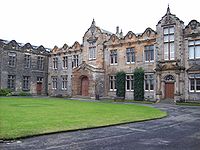
View Across St. Salvator's College
UK University Rankings
|
2010 |
2009 |
2008 |
2007 |
2006 |
2005 |
| Times Good University Guide |
4 |
5 |
5 |
20 |
7 |
9 |
| Guardian University Guide |
3 |
5 |
4 |
|
43 |
11 |
| Sunday Times University Guide |
5 |
5 |
6 |
10 |
14 |
14 |
| Complete University Guide |
7 |
7 |
5 |
|
|
|
| Daily Telegraph |
|
|
|
5 |
|
|
The independent IpsosMORI National Student Survey 2006 commissioned by HEFCE placed it third among the UK universities. It has achieved the most consistently high ratings in research assessment exercises with no subjects receiving a rating lower than 4 on a grading scale 1-5*, where 5* denotes outstanding international research. The departments of English and Psychology have received a 5*, and 72% of staff across the university received a 5 or 5* rating. The Philosophical Gourmet report ranks St Andrews' joint graduate programme in philosophy with Stirling University second in the UK.
Nearly eight in ten graduates obtain a First Class or an Upper Second Class Honours degree. A similar proportion enter further employment requiring a respected degree or obtaining placements for further postgraduate research. The ancient Scottish universities award Master of Arts degrees (except for science students who are awarded a Bachelor of Science degree) which are classified upon graduation, in contrast to Oxbridge where one becomes a Master of Arts after a certain number of years, and the rest of the UK, where graduates are awarded BAs.
The latest UCAS figures show that there are generally 12 applications per undergraduate place available, and the University has not entered Clearing since 2003. The standard offer of a place tends to require at a minimum AAABB at Scottish Highers for Scottish applicants, AAB at GCE A Levels for English, Welsh and Northern Irish candidates, or a score of at least 36 points on the International Baccalaureate.
The university has a widening participation policy; however, the university has one of the smallest percentages of students from lower income backgrounds, out of all higher education institutions in the UK. Intake from Independent schools in England is high. At the same time, the average price for accommodation for students at St Andrews is more than that for students at any other university in Scotland.
Traditions
Gowns
See also: Undergraduate gowns in Scotland
One of the most conspicuous traditions at St Andrews is the wearing of academic dress, particularly the distinctive red undergraduate gown of the United College. Undergraduates in Arts and Science subjects can be seen wearing these garments at the installation of a Rector or Chancellor, at chapel services, on 'Pier Walks', at formal hall dinners, at meetings of the Union Debating Society, or giving tours to prospective students and visitors as well as on St Andrews day, where recently many students wear their gown throughout the entire day. Divinity students wear a black undergraduate gown. (See Academic dress of the University of St Andrews.) It is considered bad luck to wear the gown when one is not a matriculated student, such an event is said to result in a similar curse as stepping on the Patrick Hamilton cobbles, the only cure for which is the May Dip.
Raisin Weekend
Raisin Weekend is the highlight of the social calendar at the University. Held annually over the last weekend of November, first years are entertained by their academic parents, normally consisting of a tea party thrown by the mothers and then a tour of pubs conducted by the fathers. This culminates in a shaving foam fight on the Monday morning in quad of St Salvator's College.
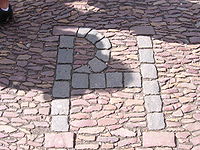
The "cursed" cobblestone initials outside St Salvators College chapel.
Cobblestones
Situated around the town of St Andrews are cobblestone markings denoting where Protestant martyrs were burnt at the stake. To students, the most notable of these is the cobblestone initials "PH" located outside the main gate of St Salvator's College. These cobblestones denote where Patrick Hamilton was martyred in 1528. According to student tradition, stepping on the "PH" will cause a student to become cursed, with the effect that the offender will fail his or her degree and so students are known to jump over the cobblestones when passing. Aside from the May Dip, an older tradition is that the remedy for this is to walk three times round the post at the end of the pier. Other, less superstitious, students pointedly do step on it to prove the tradition incorrect.
May Dip
The May Dip is a student tradition held annually at dawn on May Day. Students stay awake until dawn, at which time they collectively run into the North Sea to the sound of madrigals sung by the University Madrigal Group. The May Dip is also traditionally the only way of removing the curse inflicted by stepping on the PH cobbles. If a student is to step on the stones he/she can be forgiven if on the dawn of the first of May, they run into the North Sea.
Governance and administration
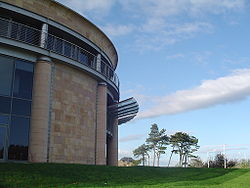
The "Gateway" building, built in 2000 and now used for the University's Management department
Main article: Governance of the University of St Andrews
As with the other Ancient universities of Scotland, governance is determined by the Universities (Scotland) Act 1858. This Act created three bodies: the General Council, University Court and Academic Senate (Senatus Academicus).
General Council
Main article: General Council of St Andrews University
The General Council is a standing advisory body of all the graduates, academics and former academics of the University. It meets twice a year and appoints a Business Committee to transact business between these meetings. Its most important functions are to appoint two Assessors to the University Court and elect the University Chancellor.
University Court
The University Court is the body responsible for administrative and financial matters, and is in effect the governing body of the University. It is chaired by the Rector, who is elected by all the matriculated students of the University. Members are appointed by the General Council, Academic Senate and Fife Council. The President of the Students' Representative Council and Director of Representation are ex officio members of the Court. Several lay members are also co-opted and must include a fixed number of alumni of the University.
Senatus Academicus
The Academic Senate (Latin Senatus Academicus) is the supreme academic body for the University. Its members include all of the Professors of the University, certain senior Readers, a number of Senior Lecturers and Lecturers and three elected student Senate Representatives - one from the Arts / Divinity faculty, one from the Science / Medicine faculty and one postgraduate student. It is responsible for authorising degree programmes and issuing all degrees to graduates. Another function of the Senate is to discipline students. The 校长 of the Senate is the University Principal.
Faculties
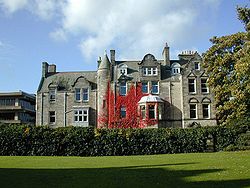
The University of St Andrews Classics Building, Swallowgate
The University is divided into four academic Faculties:
- Arts
- Divinity
- Medicine
- Science
Each is governed by a Faculty Council and administered by a Dean. Students apply to become members of a particular faculty, as opposed to any particular school or department.
Number of students by faculty
Academic Year 2005/2006 :
| Faculty |
Undergraduate |
Postgraduate |
| Arts |
3,582 |
604 |
| Divinity |
48 |
50 |
| Medicine |
419 |
7 |
| Science |
1,731 |
367 |
| Total |
5,780 |
1,028 |
Departments
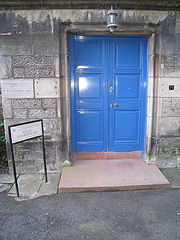
Department of Social Anthropology at St Andrews
- Department of Social Anthropology: The Anthropology Department at the University of St Andrews is noted for its research work, with recognition given to the department by research councils such as the Scottish Funding Council (SFC) in the last years and the department has achieved high standings in the latest Research Assessment Exercise (RAE).
http://ch-www.st-andrews.ac.uk/ The School of Chemistry was founded in 1811 and has undergone rapid development and improvement over the past decade. In the 2008 RAE Chemistry was ranked 4th for quality in the UK and as a consequence of its joint submission with Edinburgh chemistry it was ranked 1st in the 'power rating'. Currently The School of Chemistry has 35 academic staff, over 120 PhD students, and 80 postdoctoral research workers with outstanding research in synthesis (e.g. selenium chemistry, http://en.wikipedia.org/wiki/Woollins_reagent carbenes, fluorocarbons) energy storage and conversion (fuel cells and lightweight batteries) X-ray crystallography (e.g. robotic chemical crystallography), biological chemistry and surface science. The current Head of School is Derek Woollins.
Office of the Principal
The Principal is the chief executive of the University and is assisted in that role by several key officers.
The current composition of the Office of the Principal is:
- Principal and Vice-Chancellor: Dr Louise Richardson
- Deputy Principal and Vice-Principal (Research): Professor Christopher Hawkesworth FRS
- Master of the United College: Professor Neville Richardson
- Vice-Principal (Governance and Planning): Professor Ronald Piper
- Vice-Principal (Learning and Teaching): Professor Pat Willmer
- Vice-Principal (External Relations): Mr Stephen Magee
- Proctor and Provost of St Leonard's College: Professor Peter Clark
- Quaestor and Factor: Derek Watson
Deans of the Faculties
The Deans are academics appointed by the Master of the United College to oversee the day to day runnings of each faculty. They were once elected by their constituents but this was changed to appointment in 2005
The current Deans are:
- Dean of the Faculty of Arts: Professor Roy Dilley
- Dean of the Faculty of Divinity: Professor James Davila
- Dean of the Faculty of Medicine: Professor R. Hugh MacDougall
- Dean of the Faculty of Science: Professor Alyson Tobin
Student Residence Halls
St Andrews is characterised amongst Scottish Universities as having a significant number of students in University operated accommodation. Approximately half of the overall student population live 'in Hall'. All are now co-educational and non-smoking. Residences include:
- Albany Park
- Andrew Melville Hall
- David Russell Apartments (built on the site of the now-demolished original David Russell Hall)
- Deans Court (Postgraduate only)
- Fife Park
- Gannochy House (Postgraduate only)
- John Burnet Hall (known as Atholl, and was male only)
- McIntosh Hall (known as Chattan, and was female only)
- New Hall
- St Regulus Hall (originally male only)
- St Salvator's Hall (originally male only)
- Stanley Smith House & Angus House (Postgraduate only)
- University Hall (originally female only)
Former residences
In addition to the residences listed above, the University formerly also had the following residences:
- Hamilton Hall
- Hepburn Hall - (although Hepburn remains a university residence under lease)
- Southgait Hall - (Largely rebuilt in the 1990s and still let to students albeit privately)
- Kinnessburn Hall
- David Russell Hall
- Bishops Hall (now part of St Leonards School)
and West Park, which was pulled down to make way for the Students' Union building, built in the 1970s.
The University guarantees every student a place of accommodation. For this reason, when 400 extra students joined for the 2008/09 academic year, the university had to rent out flats in the previously sold Hepburn Hall to accommodate the rise in student numbers.
Notable alumni
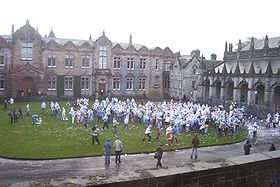
St Salvator's Quadrangle during the Raisin Weekend foam fight
See also Category:Alumni of the University of St Andrews
Arts & Media
- Robert Ayton, poet
- Crispin Bonham-Carter, actor
- Bruce Marshall, novelist
- Andrew Crumey, novelist
- Gilbert Hay, poet, counted among the Scots Makars
- Gavin Douglas, poet and bishop, counted among the Scots Makars
- William Dunbar, poet, counted among the Scots Makars
- Alexander Hume, poet, counted among the Scots Makars
- William Fowler, poet, counted among the Scots Makars
- Robert Fergusson, poet
- Sarah Hall (writer), novelist
- Hazel Irvine, television presenter
- Sir David Lindsay, poet and diplomat
- Ian McDiarmid, actor
- Louise Minchin, newsreader
- Siobhan Redmond, actor
- Alastair Reynolds, science fiction author
- Brian Taylor, journalist
- Fay Weldon, feminist and writer
- Timothy Williams, novelist
- William Tennant, poet
Philosophers, Academia & Education
- Robert Balfour, philosopher
- Andrew Bell (educationalist), Scottish Anglican priest and educationalist, founder of Madras College
- Sir Eric Anderson, academic, Provost of Eton College
- Kieron O'Hara, philosopher and political writer
- Walter Perry, Lord Perry of Walton, first Vice-Chancellor of the Open University
- Dominic Sandbrook, historian and author
- Lawrence Stenhouse, educational researcher
- Russell Kirk, American political theorist, historian, and fiction author
- G. W. S. Barrow, arguably the most prominent Scottish medievalist of the last century
- John Honey, student who rescued five men from a ship
Business & Law
- Lord Colonsay, former Lord Advocate and Lord Justice General
- Lord Cullen, former Lord 校长 of the Court of Session and Lord Justice General
- Lord Eassie, Judge of the Inner House of the Court of Session
- Sir John Rose (Rolls-Royce), CEO of Rolls-Royce plc
- Olivier Sarkozy, senior investment banker and half brother of French President, Nicolas Sarkozy
Politics & Public Affairs
- John Campbell, 1st Baron Campbell, Liberal Politician and lawyer
- Archibald Campbell, 1st Marquess of Argyll, 8th Earl of Argyll, chief of Clan Campbell
- Angie Bray, Conservative and Unionist politician
- Henry Balnaves, Scottish politician and religious reformer
- Malcolm Bruce, Liberal Democrat MP
- Thomas Bruce, 7th Earl of Elgin, diplomat
- Christopher Chope, Conservative and Unionist politician
- Barry Gardiner, Labour Party politician, MP
- Marlyn Glen, Scottish Labour politician, and Member of the Scottish Parliament for North East Scotland region since 2003.
- James Graham, 1st Marquess of Montrose, royalist military commander
- John Graham, 1st Viscount of Dundee, Jacobite military commander, "Bonnie Dundee"
- John Campbell, 9th Duke of Argyll, British nobleman and was Governor General of Canada from 1878 to 1883
- Michael Fallon, Conservative and Unionist politician, MP
- Michael Forsyth, Baron Forsyth of Drumlean, Conservative and Unionist politician
- Arthur Hobhouse, architect of the system of National parks of England and Wales, MP
- Mark Lazarowicz, Labour Party politician
- John MacGregor, Baron MacGregor of Pulham Market, Conservative and Unionist politician
- Lewis Moonie, Baron Moonie, Labour Party politician, MP
- Madsen Pirie, founder, Adam Smith Institute
- Lyon Playfair, 1st Baron Playfair, scientist and Liberal politician
- George Reid, Scottish National Party politician and second Presiding Officer of the Scottish Parliament
- Alex Salmond, First Minister of Scotland and leader of the Scottish National Party
- John Sawers, British Ambassador to the UN and next Director of MI6
- Alex Singleton, Political Commentator and Former President of the Globalisation Institute
- Catherine Stihler, Labour Party politician
- Jamie Stone, Liberal Democrat Member of the Scottish Parliament
- Desmond Swayne, Conservative and Unionist politician
- Hugo Swire, Conservative and Unionist politician
- James Wilson, signatory of the United States Declaration of Independence
Religion, Church & Theology
- David Beaton, Cardinal Archbishop of St Andrews
- James Beaton, Scottish church leader, the uncle of Cardinal David Beaton
- George Buchanan, scholar, theologian, and playwright
- Reverend Alexander Duff, DD, LLD, missionary and founder of Scottish Church College, Calcutta
- Thomas Chalmers, theologian and leader of the Free Church of Scotland
- Colin Falconer, 17th century Scottish minster and bishop
- George Gillespie, Scottish theologian
- Patrick Hamilton, Protestant Reformer, early martyr of the Scottish Reformation+
- Alexander Henderson, theologian
- John Knox, theologian, leader of the Protestant Reformation who is considered the founder of the Presbyterian Church of Scotland
- Andrew Melville, scholar and theologian and religious reformer
- Rev John Munro of Tain, dissenter opposing reforms of James VI.
- Victor Premasagar, Old Testament Scholar and Moderator of Church of South India
- Klyne Snodgrass, American scholar and theologian
- Sheila Watson, archdeacon
- John Witherspoon, theologian, President of Princeton University, and signatory of the U.S. Declaration of Independence.
- Christopher Woods, Chaplain of Christ's College, University of Cambridge
Royalty
- King James II of Scotland
- Prince William of Wales (known at university as William Wales)
Sciences
- Joseph Bancroft, surgeon and parasitologist born in England, who emigrated to Australia
- Alexander Berry, explorer, Australian pioneer/settler Coolangatta
- Sir Douglas Black, physician and the author of Black Report
- James Black, Nobel prize winner in Medicine
- Saba Douglas-Hamilton, British wildlife conservationist and television presenter
- Professor John Garrow, Honorary consultant physician, chairman of HealthWatch, Joint Advisory Committee on Nutrition Education and Association for the Study of Obesity
- James Gregory, astronomer and mathematician, has been said that "Of the British mathematicians of the seventeenth century, Gregory was only excelled by Newton."
- Walter Haworth, Nobel prize winner in Chemistry
- Francis Robert Japp, British Chemist who discovered the Japp–Klingemann reaction in 1887.
- Edward Jenner, Doctor of Medicine, first doctor to introduce & study the Smallpox vaccine
- Alan MacDiarmid, Nobel prize winner in Chemistry
- John Napier, mathematician, inventor of logarithms
Other
- James Crichton, polymath, the original "Admirable Crichton"
- Findlay S. Douglas, former President of the United States Golf Association
- Anthony Dickson Home, Served as Surgeon General of the British Army. Awarded the Victoria Cross
- Chris Hoy, World, Olympic and Commonwealth Cycling Champion
- Charles B. Macdonald, a major figure in early American golf.
- Kate Middleton, Prince William's girlfriend
- William Gordon Rutherfurd, Commander of HMS Swiftsure at the battle of Trafalgar.
- Barney White-Spunner, Commander of the British Field Army
- George Kennedy Young, Deputy Director of MI6 and Merchant Banker
Famous Rectors
In Scotland, the position of Rector exists in the four ancient universities (St Andrews, Glasgow, Aberdeen and Edinburgh) - as well as in the University of Dundee. The post (officially Lord Rector, but by normal use Rector alone) was made an integral part of these universities by the Universities (Scotland) Act 1889. The Rector of the University of St Andrews chairs meetings of the University Court, the governing body of the university, and is elected at regular intervals by the matriculated student body
- Charles Neaves, Lord Neaves 1872–1874, Scottish theologian, jurist and evolution analyst
- John Cleese 1970-1973, English actor and comedian
- Rudyard Kipling 1922-1925, Nobel Prize winner, British author and poet
- Andrew Carnegie 1901-1907, Scottish-born American businessman, philanthropist
- John Stuart Mill 1865-1868, English philosopher and political economist
- Douglas Haig, 1916–1919, Senior British Commander of World War I
- J. M. Barrie, 1919–1922, Scottish author of Peter Pan
- Fridtjof Nansen, 1925–1928, Norwegian explorer, scientist, diplomat and Nobel Peace Prize winner
Links with the United States
The University has a strong link with the United States. Significant numbers of students matriculate from the United States. Many important American figures (and emigrants to the United States) from Scotland have been associated with the university:
- Andrew Carnegie, Lord Rector of the University. See the following link to the NY Times article which documents his controversial Inaugural Address: LORD RECTOR CARNEGIE.
- Bill Bryson, author.
- Bobby Jones, golfer.
- Guy Sands-Pingot, Brigadier General, USAR.
- Bob Dylan, awarded honorary degree.
- Michael Douglas, awarded honorary degree.
- Jonathan Taylor Thomas, actor, exchange student.
Signatories of the Declaration of Independence
Also, three of the signatories of the 1776 American Declaration of Independence attended or received degrees from St Andrews, including:
- James Wilson, born at Carskerdo, near Cupar (signer from the state of Pennsylvania)
Wilson attended three Scottish Universities including St Andrews, but did not earn a degree from any of them. Carrying important letters of introduction, Wilson arrived in the US in 1765. He became a Latin tutor at Philadelphia College (now the University of Pennsylvania), and successfully petitioned that institution to grant him an honorary Master of Arts.
- John Witherspoon, born at Gifford, East Lothian (signer from the state of New Jersey)
Witherspoon had an impressive list of credentials and was a significant public figure. He was president of the College of New Jersey (now Princeton University). Witherspoon was largely responsible for converting the institution into a success by employing Scottish educational standards. He received his Master of Arts, Bachelor of Divinity, and was made a Doctor of Divinity at the University of St Andrews.
- Benjamin Franklin, born Boston, Massachusetts (signer from the state of Pennsylvania)
In 1759 Franklin received an honorary degree of Doctor of Laws from the University of St Andrews.
Exchange Programmes
Emory University in Atlanta runs an exchange programme with St Andrews called the Bobby Jones Scholars programme, which allows for recent graduates of both universities to study at the other university. In addition, the School of Physics and Astronomy maintains a postgraduate exchange with The Georgia Institute of Technology. Both of these exchanges are funded by the Robert T. Jones Memorial Trust. The Robert Lincoln McNeil Scholarship is run in conjunction with the University of Pennsylvania. One of the largest exchanges is with the University of California, and students are routinely sent to Berkeley, UCLA, and UCSD. The School of International Relations and the School of Modern Languages also oversee an undergraduate student exchange with Sciences Po in Paris.
University of St Andrews
Any alumnus, student or staff member can wear a scarf of dark blue, sky blue and white:
University of St Andrews
St Mary's College
Bute Medical School
St Leonard's College (Postgraduate)
Student organisations
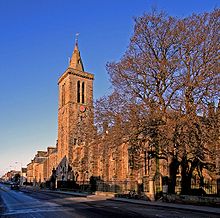
St Salvator's Chapel viewed from North Street.
Students' Association
The University of St Andrews Students' Association is the organisation which represents the student body of the University of St Andrews. The Association was instituted in 1983 under the Constitution and Laws of the University of St Andrews Students’ Association. It comprises the Students' Representative Council (SRC), established in 1885 and legally defined under the Universities (Scotland) Act 1889, and the Students' Union (which was itself a merger of the Students' Union and the Women's Union). The Students' Association is registered with the Office of the Scottish Charity Regulator as charity SCO19883
The Students' Association Building (colloquially known as the Union) is located on St Mary's Place, St Andrews. External bodies operating in the building include a Blackwells bookshop and the University's Student Support Services. The Students' Association is affiliated to, and indeed a founding member of, the Coalition of Higher Education Students in Scotland (CHESS) and is not a member of the National Union of 学生.
The Students' Association receives a maintenance grant from the University, which stood at £159,000 GBP for the academic year 2004-2005.
The Students' Association is headed up by four sabbatical officers. Currently they are Andrew Keenan (Association President), Georgina Rannard (Director of Representation), Phil Pass (Director of Events and Services) and Matthew Guest (Director of Student Development and Activities).
Societies
Students at the university form various voluntary societies for academic, social, artistic, political, religious and other purposes. Many of these are affiliated with the Students' Association, such as the University of St Andrews Union Debating Society and the Just So Society which recently put on the controversial musical 'Jerry Springer: The Opera' which attracted both protesters and national press attention. Among the most recently affiliated societies there is The Sandclock Society. Other groups are not affiliated to the University or the Students Association, and therefore not a part of the University structure. Notable independent student groups include the Global Investment Group, the International Politics Association, The Psychology Society, The Philosophy Society, Left Society and The Regulus.
The university's Music Society comprises many student-run musical groups, including the University's main symphony orchestra, wind band, and chorus. They also organise their own series of weekly lunchtime recitals. Musical groups at the university also include several choirs, among them the University's St Salvator's Chapel Choir, St Leonard's Chapel Choir, St Salvator's Chapel Chamber Choir as well as the student-run Madrigal Group.
Students and Staff from the University of St Andrews are developing the unique Project Zambia. Piloted in 2009, the project is now embedded in the work of the Department of Sport and Exercise and the Student Experience Office in the University of St Andrews. Students are recruited from two sections of the University's student body: top performance athletes are chosen for their commitment to sport, while students who have shown commitment to pastoral volunteering, aiding their fellow students, are chosen to extend their experience in the caring professions.The students, and staff seeking professional development, travel to Zambia to live and work in the communities, schools and orphanages for the summer months in conjunction with the Zambian organisation 'Sport In Action'.
Athletic Union
The University of St Andrews Athletic Union is the Student representative body for sport.
- University of St Andrews Rugby Football Club (Founded 1858)
Media
- Newspapers:
- The Saint is the longest-lived student newspaper, published fortnightly since 1997 and tracing its roots several decades further. It is fully independent of both the Student's Union and the University, which has led to some controversy about certain articles in the past. This independence is only matched by four other student newspapers in Britain - Felix at Imperial College London, Cherwell in Oxford, Varsity in Cambridge and The Inquirer at City University in London
- On 17 April 2006, the Vine magazine (supported by the Students' Association) was re-launched. The magazine claimed to generate discussion and thought throughout the student population of the town, and was printed at irregular intervals. Sales were poor, and the publication eventually closed down in 2007.
- The Tribe "an off-beat art and lifestyle publication appealing to University of St Andrews students passionate about journalism and photography" was launched in 2009.
- The Regulus Magazine, founded in January 2010, is a student-run publication entirely devoted to political and economic affairs featuring contributions from prestigious members of the international community.
- Academic Journals:
- In 2007 the James Crichton Society was created to foster "academic inquiry and discussion". It produced a monthly journal but has since ceased to publish.
- St. Andrews Psychology Review (S.P.R.) founded in 2008 in association with St. Andrews Psychology Department and the The St. Andrews Psychology Society (independently funded and not affiliated with The St. Andrews Student Union.) While it is the first Independent Academic Journal at The University St. Andrews it has a number of individuals who aren’t university staff or students as writers and staff.
- Aporia (The Philosophy Society Journal) A biannual journal founded in 2007. The articles featured are predominantly be papers written on philosophical topics by St. Andrews' students.
- Ha@sta, a student produced annual journal for those interested in the History of Art has been published since 1995.
- There is a postgraduate journal for Museum and Gallery Studies.
- Radio:
- On 28 February 2005, a number of St Andrews students launched the University's first FM station broadcasting over 5 km on the 87.7 MHz frequency. The station was granted a Restricted Service Licence by Ofcom, which allowed for six hours of broadcast a day. Subsequent periods of broadcast followed until the end of 2007, when it was decided to re-brand Star FM as STAR or St Andrews Radio and broadcast solely as an Internet station online for twenty-four hours a day. The radio station is now a sub-committee of the Students' Association under the name of the Broadcasting Committee. It broadcasts 24/7 during University term time. The station can be found at www.standrewsradio.com.
- Web:
- An independent website has been set up by students at the University for topical discussion and an unbiased review of the town and University. This can be found at TheSinner.net
- On 15 August 2009, a group of independent St Andrews students launched a detailed and interactive unofficial 'survival guide' for incoming undergraduates, providing information on the town and university life. The guide features a Twitter feed to interact with new students and a newsletter that encourages dialogue with current students. The guide is at StAndrewsFreshers.com although neither of these has been updated since August 31st 2009.
- In 2010 StAnd Science, a student science and technology blog was launched. At the end of March 2010 its first paper issue will be launched.
更多
- Chancellor of the University of St Andrews
- Rector of the University of St Andrews
- Ancient universities of Scotland
- Academic dress of the University of St Andrews
- Academics of the University of St Andrews
参考文献
- ^ http://foi.st-andrews.ac.uk/PublicationScheme/servlet/core.generator.gblobserv?id=1539
- ^ http://www.st-andrews.ac.uk/publications/univ_statistics.shtml#StaffNumbers
- ^ "Table 0a - All students by institution, mode of study, level of study, gender and domicile 2005/06". Higher Education Statistics Agency online statistics. http://www.hesa.ac.uk/holisdocs/pubinfo/student/institution0506.htm. Retrieved 2007-04-05.
- ^ "Online Catalogue > University Branded Clothing > Hats, Scarves, Ties > Scarves". University of St Andrews Students' Association Shop. http://www.yourunionshop.net/acatalog/Scarves.html. Retrieved 2007-04-06.
- ^ "Scarves of the University of St Andrews". http://www.netsoc.tcd.ie/~peterh/scarves/standrews/. Retrieved 2007-04-06.
- ^
 "University of Saint Andrews". Catholic Encyclopedia. New York: Robert Appleton Company. 1913. http://en.wikisource.org/wiki/Catholic_Encyclopedia_(1913)/University_of_Saint_Andrews. "University of Saint Andrews". Catholic Encyclopedia. New York: Robert Appleton Company. 1913. http://en.wikisource.org/wiki/Catholic_Encyclopedia_(1913)/University_of_Saint_Andrews.
- ^ http://www.gashe.ac.uk:443/isaar/P0243.html
- ^ http://www.st-andrews.ac.uk/semesterdates/
- ^ "The Times Good University Guide". The Times. http://extras.timesonline.co.uk/tol_gug/gooduniversityguide.php. Retrieved 06-03-2009.
- ^ "The Sunday Times Good University Guide League Tables". The Sunday Times. http://extras.timesonline.co.uk/tol_gug/gooduniversityguide.php. Retrieved 04-09-2008.
- ^ "The Times Good University Guide 2008". The Times. http://extras.timesonline.co.uk/gug/gooduniversityguide.php. Retrieved 03-11-2007.
- ^ "The Times Good University Guide 2007 - Top Universities 2007 League Table". The Times. http://www.timesonline.co.uk/displayPopup/0,,102571,00.html. Retrieved 2007-11-03.
- ^ "The Times Top Universities". The Times. http://www.timesonline.co.uk/displayPopup/0,,32607,00.html. Retrieved 2007-11-03.
- ^ "University guide 2010: University league table". 12 May 2009. http://www.guardian.co.uk/education/table/2009/may/12/university-league-table.
- ^ "University ranking by institution". The Guardian. http://browse.guardian.co.uk/education?SearchBySubject=false&FirstRow=0&SortOrderDirection=&SortOrderColumn=GuardianTeachingScore&Subject=Subject&Go=Go. Retrieved 2007-10-29.
- ^ "University ranking by institution". The Guardian. http://browse.guardian.co.uk/education?SearchBySubject=&FirstRow=0&SortOrderDirection=&SortOrderColumn=GuardianTeachingScore&Subject=University+ranking&Institution=. Retrieved 2007-10-29.
- ^ "University ranking by institution". The Guardian. http://browse.guardian.co.uk/education/2006?SearchBySubject=&FirstRow=40&SortOrderDirection=&SortOrderColumn=GuardianTeachingScore&Subject=Institution-wide&Institution=. Retrieved 2007-10-29.
- ^ "University ranking by institution". The Guardian. http://education.guardian.co.uk/universityguide2005/table/0,,-5163901,00.html?start=10&index=3&index=3. Retrieved 2007-10-29.
- ^ "The Sunday Times Good University Guide League Tables". The Sunday Times. http://extras.timesonline.co.uk/stug/universityguide.php. Retrieved 2009-09-13.
- ^ "The Sunday Times University League Table" (PDF). The Sunday Times. http://extras.timesonline.co.uk/stug2006/stug2006.pdf. Retrieved 2007-11-03.
- ^ "University ranking based on performance over 10 years" (PDF). Times Online. 2007. http://extras.timesonline.co.uk/pdfs/univ07ten.pdf. Retrieved 2008-04-28.
- ^ "The Complete University Guide 2010". Complete University Guide. http://www.thecompleteuniversityguide.co.uk/single.htm?ipg=8726.
- ^ "The Independent University League Table". The Independent. http://www.independent.co.uk/news/education/higher/the-main-league-table-2009-813839.html.
- ^ "University league table". The Daily Telegraph. http://www.telegraph.co.uk/news/main.jhtml;jsessionid=HXFCSGXMNVABTQFIQMFCFGGAVCBQYIV0?xml=/news/2007/07/30/ncambs430.xml. Retrieved 2007-10-29.
- ^ National Student Survey: results by institution (2006 figures only)| Students| EducationGuardian.co.uk
- ^ "Research at St Andrews: RAE 2001". http://www.st-andrews.ac.uk/~rsrchweb/rae/rae_2001.shtml.
- ^ "Overall Rankings". http://www.philosophicalgourmet.com/overall.asp.
- ^ "Access agenda is now back on track". The Times. http://www.timeshighereducation.co.uk/story.asp?storyCode=209682§ioncode=26. Retrieved 25 November 2008.
- ^ "Cost of students’ rent soars to record levels". The Scotsman. http://www.theherald.co.uk/news/news/display.var.2422057.0.cost_of_students_rent_soars_to_record_levels.php. Retrieved 25 November 2008.
- ^ "RAE 2008". http://www.rae.ac.uk/Submissions/submission.aspx?id=182&type=hei&subid=584.
- ^ "Bio on James Wilson". Pennsylvania Center for the Book, University Libraries of Penn State University. http://www.pabook.libraries.psu.edu/palitmap/bios/Wilson__James.html. Retrieved 2009-01-03.
- ^ University of St Andrews (24 January 2006). "Publication Scheme – Category 13 – Class: Relationship with Students’ Association". Press release. http://foi.st-andrews.ac.uk/PublicationScheme/servlet/core.generator.gblobserv?id=367. Retrieved 2007-07-23.
- ^ "Ministry of Justice - Universities (Scotland) Act 1889". http://www.statutelaw.gov.uk/content.aspx?LegType=All+Legislation&title=Universities+(Scotland)+Act&Year=1889&searchEnacted=0&extentMatchOnly=0&confersPower=0&blanketAmendment=0&sortAlpha=0&TYPE=QS&PageNumber=1&NavFrom=0&parentActiveTextDocId=1061283&ActiveTextDocId=1061283&filesize=70634.
- ^ "Extract from the Scottish Charity Register maintained by OSCR". http://www.oscr.org.uk/CharityIndexDetails.aspx?id=19883.
- ^ http://www.theherald.co.uk/news/news/display.var.2503033.0.Christian_activists_target_Springer_in_St_Andrews.php
- ^ http://jamescrichtonsociety.webs.com/index.htm
- ^ http://www.st-andrews.ac.uk/~philsoc/journal.htm
- ^ [1]
- ^ [2]
Sources
- University of St Andrews - Facts and Figures
- http://browse.guardian.co.uk/education?SearchBySubject=true&Subject=University+ranking&Institution=St+Andrews&Go=Go
- R.G. Cant The University of St Andrews, A Short History (Oliver and Boyd Ltd. 1946)
External links
- University of St Andrews website
- StAndrewsFreshers
- University of St Andrews Students' Association 网址
- University of St Andrews Student Radio
- The Saint - Student Newspaper
- The Sinner - Independent Student Website and Guide to St Andrews
- The MacTutor History of Mathematics archive
- Project Zambia
|
|



